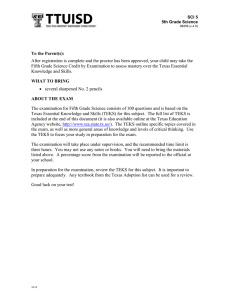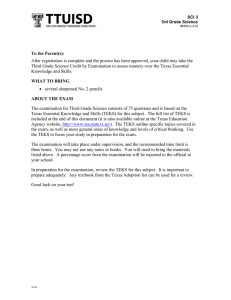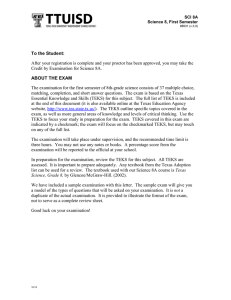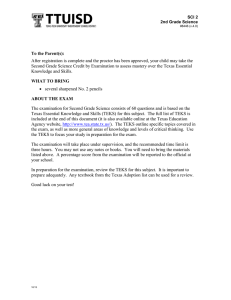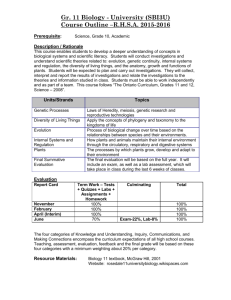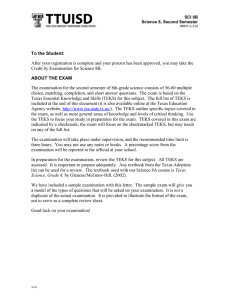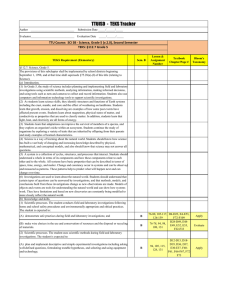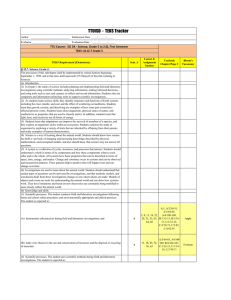After registration is complete and the proctor has been approved,... Fourth Grade Science Credit by Examination to assess mastery over... To the Parent(s):
advertisement
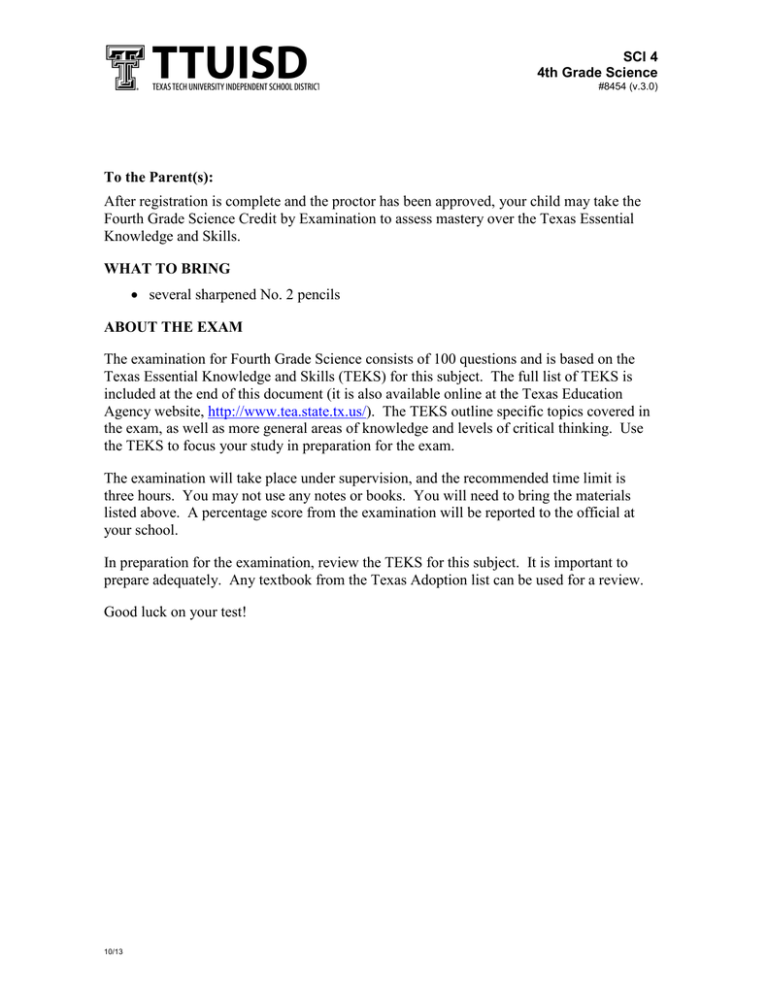
SCI 4 4th Grade Science #8454 (v.3.0) To the Parent(s): After registration is complete and the proctor has been approved, your child may take the Fourth Grade Science Credit by Examination to assess mastery over the Texas Essential Knowledge and Skills. WHAT TO BRING • several sharpened No. 2 pencils ABOUT THE EXAM The examination for Fourth Grade Science consists of 100 questions and is based on the Texas Essential Knowledge and Skills (TEKS) for this subject. The full list of TEKS is included at the end of this document (it is also available online at the Texas Education Agency website, http://www.tea.state.tx.us/). The TEKS outline specific topics covered in the exam, as well as more general areas of knowledge and levels of critical thinking. Use the TEKS to focus your study in preparation for the exam. The examination will take place under supervision, and the recommended time limit is three hours. You may not use any notes or books. You will need to bring the materials listed above. A percentage score from the examination will be reported to the official at your school. In preparation for the examination, review the TEKS for this subject. It is important to prepare adequately. Any textbook from the Texas Adoption list can be used for a review. Good luck on your test! 10/13 Texas Essential Knowledge and Skills SCI 4 – Grade 4 Science §112.6. Science, Grade 4. The provisions of this subchapter shall be implemented by school districts beginning September 1, 1998, and at that time shall supersede §75.28(a)-(f) of this title (relating to Science). (a) Introduction. (1) In Grade 4, the study of science includes planning and implementing field and laboratory investigations using scientific methods, analyzing information, making informed decisions, and using tools such as compasses to collect information. Students also use computers and information technology tools to support scientific investigations. (2) As students learn science skills, they identify components and processes of the natural world including properties of soil, effects of the oceans on land, and the role of the Sun as our major source of energy. In addition, students identify the physical properties of matter and observe the addition or reduction of heat as an example of what can cause changes in states of matter. (3) Students learn the roles of living and nonliving components of simple systems and investigate differences between learned characteristics and inherited traits. They learn that adaptations of organisms that lived in the past may have increased some species' ability to survive. (4) Science is a way of learning about the natural world. Students should know how science has built a vast body of changing and increasing knowledge described by physical, mathematical, and conceptual models, and also should know that science may not answer all questions. (5) A system is a collection of cycles, structures, and processes that interact. Students should understand a whole in terms of its components and how these components relate to each other and to the whole. All systems have basic properties that can be described in terms of space, time, energy, and matter. Change and constancy occur in systems and can be observed and measured as patterns. These patterns help to predict what will happen next and can change over time. (6) Investigations are used to learn about the natural world. Students should understand that certain types of questions can be answered by investigations, and that methods, models, and conclusions built from these investigations change as new observations are made. Models of objects and events are tools for understanding the natural world and can show how systems work. They have limitations and based on new discoveries are constantly being modified to more closely reflect the natural world. (b) Knowledge and skills. (1) Scientific processes. The student conducts field and laboratory investigations following home and school safety procedures and environmentally appropriate and ethical practices. The student is expected to: (A) demonstrate safe practices during field and laboratory investigations; and (B) make wise choices in the use and conservation of resources and the disposal or recycling of materials. (2) Scientific processes. The student uses scientific inquiry methods during field and laboratory investigations. The student is expected to: (A) plan and implement descriptive investigations including asking well-defined questions, formulating testable hypotheses, and selecting and using equipment and technology; (B) collect information by observing and measuring; (C) analyze and interpret information to construct reasonable explanations from direct and indirect evidence; (D) communicate valid conclusions; and (E) construct simple graphs, tables, maps, and charts to organize, examine, and evaluate information. (3) Scientific processes. The student uses critical thinking and scientific problem solving to make informed decisions. The student is expected to: (A) analyze, review, and critique scientific explanations, including hypotheses and theories, as to their strengths and weaknesses using scientific evidence and information; (B) draw inferences based on information related to promotional materials for products and services; (C) represent the natural world using models and identify their limitations; (D) evaluate the impact of research on scientific thought, society, and the environment; and (E) connect Grade 4 science concepts with the history of science and contributions of scientists. (4) Scientific processes. The student knows how to use a variety of tools and methods to conduct science inquiry. The student is expected to: (A) collect and analyze information using tools including calculators, safety goggles, microscopes, cameras, sound recorders, computers, hand lenses, rulers, thermometers, meter sticks, timing devices, balances, and compasses; and (B) demonstrate that repeated investigations may increase the reliability of results. 2 (5) Science concepts. The student knows that complex systems may not work if some parts are removed. The student is expected to: (A) identify and describe the roles of some organisms in living systems such as plants in a schoolyard, and parts in nonliving systems such as a light bulb in a circuit; and (B) predict and draw conclusions about what happens when part of a system is removed. (6) Science concepts. The student knows that change can create recognizable patterns. The student is expected to: (A) identify patterns of change such as in weather, metamorphosis, and objects in the sky; (B) illustrate that certain characteristics of an object can remain constant even when the object is rotated like a spinning top, translated like a skater moving in a straight line, or reflected on a smooth surface; and (C) use reflections to verify that a natural object has symmetry. (7) Science concepts. The student knows that matter has physical properties. The student is expected to: (A) observe and record changes in the states of matter caused by the addition or reduction of heat; and (B) conduct tests, compare data, and draw conclusions about physical properties of matter including states of matter, conduction, density, and buoyancy. (8) Science concepts. The student knows that adaptations may increase the survival of members of a species. The student is expected to: (A) identify characteristics that allow members within a species to survive and reproduce; (B) compare adaptive characteristics of various species; and (C) identify the kinds of species that lived in the past and compare them to existing species. (9) Science concepts. The student knows that many likenesses between offspring and parents are inherited or learned. The student is expected to: (A) distinguish between inherited traits and learned characteristics; and (B) identify and provide examples of inherited traits and learned characteristics. (10) Science concepts. The student knows that certain past events affect present and future events. The student is expected to: (A) identify and observe effects of events that require time for changes to be noticeable including growth, erosion, dissolving, weathering, and flow; and (B) draw conclusions about "what happened before" using fossils or charts and tables. (11) Science concepts. The student knows that the natural world includes earth materials and objects in the sky. The student is expected to: (A) test properties of soils including texture, capacity to retain water, and ability to support life; (B) summarize the effects of the oceans on land; and (C) identify the Sun as the major source of energy for the Earth and understand its role in the growth of plants, in the creation of winds, and in the water cycle. Source: The provisions of this §112.6 adopted to be effective September 1, 1998, 22 TexReg 7647. 3
